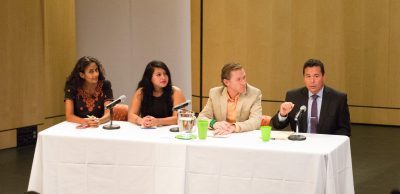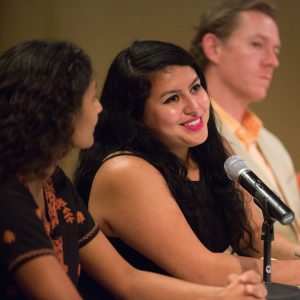At a time when schisms dominate political headlines, the president of the California State Senate joined environmental experts at Pitzer College’s Air Quality in Southern California Summit on October 6 to speak about a common cause in the Golden State: the air we breathe.
“Together we will clean up our air,” said Pitzer alumnus and California Senate President pro Tempore Kevin de León ’03, who delivered the summit’s keynote address. “Together we will be an example for the entire world.”
The summit came at a critical time, said Brinda Sarathy, director of Pitzer’s Robert Redford Conservancy for Southern California Sustainability, which organized the event. During a year that is on track to be the hottest in recorded history, the meeting of minds was held in the suburbs of Los Angeles—an urban area plagued by the worst ozone pollution in the US. The summit came a year after the onset of the Porter Ranch gas leak, which The New York Times called the most disastrous gas leak in American history, and eight months after California Governor Jerry Brown proposed a plan to spend $176.6 million to test and clean up lead-contaminated homes around the now-shuttered Exide plant in Vernon.
“We want to engage our students and the broader public on critically important environmental challenges facing the region and the world,” said Sarathy, who is an associate professor of environmental analysis at Pitzer. “We need a wide range of solutions to tackle such huge problems.”
 L-R: Brinda Sarathy, Nancy Martinez, Timothy O’Connor, Joseph Lyou
L-R: Brinda Sarathy, Nancy Martinez, Timothy O’Connor, Joseph Lyou
The summit included an all-star panel featuring Joseph Lyou, president of the Coalition for Clean Air and a board member of the South Coast Air Quality Management District (SCAQMD); Timothy O’Connor, director of the Environmental Defense Fund’s Oil and Gas Program in California; and Nancy Martinez, a reporter with Eastern Group Publications. Along with de León, they explored a raft of interconnected issues, ranging from particulate matter to political matters.
O’Connor noted that combustion of fossil fuels is not only “imperiling our children and our future” but comes “with a great cost to our economy.”
“In California, we burn about 20 billion gallons of gasoline and diesel fuel a year, which means that we’re sending about $50 billion outside of our state every single year,” O’Connor said.
Joseph Lyou, one of 12 board members of SCAQMD, told attendees that they were breathing some of the most polluted air in the country. Then he got more specific:
- 43% of people in the US who are breathing fine particulate matter (known as PM5) at levels deemed unhealthy by federal standards live in the South Coast Air Basin, which encompasses most of the LA area
- 48% Americans who are breathing ground-level ozone, i.e. smog, at levels exceeding federal standards, live in the South Coast Air Basin
- Each year, an estimated 2,000 deaths in the area are attributed to air pollution
Lyou stressed that contaminated air “is not an equal opportunity pollutant.” Not only are some individuals more vulnerable than others to the health effects of pollution, entire communities are disparately impacted by environmental contamination, he said.
“Unfortunately, it’s highly correlated with your income and ethnicity,” Lyou said.
 Martinez, who has covered the toxic contamination caused by Exide Technologies battery recycling plant in Vernon, CA, outlined what she called the double standard between affluent neighborhoods and predominately working-class and minority communities in California. She compared the reaction to Porter Ranch, where last year’s massive gas leak elicited a relatively rapid response by government officials, to the Exide plant, which exposed residents in surrounding communities to toxic levels of lead and arsenic for decades.
Martinez, who has covered the toxic contamination caused by Exide Technologies battery recycling plant in Vernon, CA, outlined what she called the double standard between affluent neighborhoods and predominately working-class and minority communities in California. She compared the reaction to Porter Ranch, where last year’s massive gas leak elicited a relatively rapid response by government officials, to the Exide plant, which exposed residents in surrounding communities to toxic levels of lead and arsenic for decades.
De León said all these intertwined issues mean that those dedicated to protecting the planet are “at the vanguard of one today’s most pressing civil rights issues because it’s at the intersection of health, economic prosperity and the environment.”
The day before the Air Quality in Southern California Summit, de León joined Governor Brown, former Governor Arnold Schwarzenegger and other state leaders to celebrate a major legislative milestone: the tenth anniversary of the passage of AB 32, the California Global Warming Solutions Act, which requires California to reduce its greenhouse gas emissions to 1990 levels by 2020 and was the first program in the US to take a comprehensive, long-term approach to addressing climate change. At the summit, de León highlighted AB 32 and other measures the state has taken to confront the “existential threat” of climate change and air pollution, including:
- SB 32, which was signed into law in September and extends AB 32 by calling for a 40 percent reduction of greenhouse gas emissions from 1990 levels by 2030
- The Clean Energy and Pollution Reduction Act of 2015, which set sweeping new standards for energy efficiency and put California on a path to generate half its electricity from renewables by 2030
De León said California is proving that “we don’t have to choose between a healthy economy and a healthy environment.” Approximately half a million people in the state are now employed in the clean energy sector, he said. California’s investment in alternatives to fossil fuels is part of a plan “to make sure that clean energy is not boutiquish, not just for those who live in the Palisades, but for those who live in Pomona or Pacoima.”
“California is not a leader, it’s the leader,” de León said. “We have to do it right.”
Save
Save